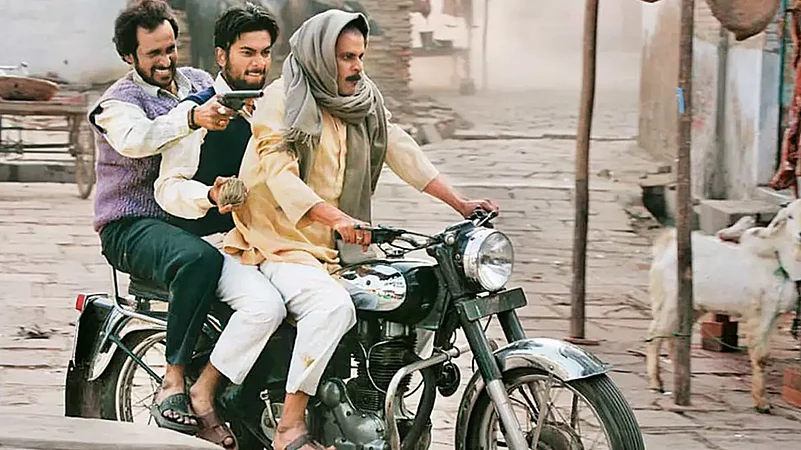Cinema in India is not just entertainment. It resides in the heart and soul of this country. People's sorrows and happiness are reflected in cinema. There has been a custom in this country to worship film personalities and build their temples. This is why the current status of Hindi films has become a national issue.
Everyone has an opinion on the recurring failure of Hindi films in recent times. It is being said vociferously that the time of Hindi films is over. But I think it is just like the debates on the country's defence, foreign and economic policies that take place in every other street, which have no basis other than sheer sentimentality. Actually, one has to go delve deep to understand the current situation in Hindi cinema.
It is said that Hindi films have lost their sheen in comparison to South Indian cinema. However, when it is asserted, its basis is not stated. Going by the statistics, around 53 Hindi films were released, out of which five crossed the magic mark of Rs 100 crore this year. If a box-office collection of Rs 100 crores is considered to be the yardstick for the success of any film, then only 15 of the more than 370 films made in South India have crossed the magic figure this year. This shows that not only Hindi films but Malayalam, Kannada, Tamil, and Telugu language movies are also falling flat at the ticket counters.
Every industry faces good and bad times. Today, the flaws of the Hindi film industry are clearly visible, but there is a flip side as well. It will ultimately help it improve itself in the future. If we talk about the reasons for the failure of Hindi films, some important points have to be discussed at length. Firstly, there is an acute dearth of theatres in the Hindi belt. Out of the total number of theaters in India, more than 50 per cent theatres exist in South India alone. The Hindi belt does not have an adequate number of theatres. Earlier, every city had four to five cinema halls. Now, there are no theatres left in small towns and cities. When you don't have a good-quality theatres in such places, why will the audience come out to watch movies in the first place?
Besides, the country faced a huge economic crisis due to the Coronavirus pandemic. The common man is now barely able to earn enough money for his basic needs. The audiences are, therefore making a very careful choice about how to spend their hard-earned money on entertainment. Also, OTT medium has given the facility to the viewer to watch the movie of his choice at home. Unless a film is eagerly awaited for years or a film is talked about enough across the country, the audiences do not want to go to the theatre to watch a film.
The biggest weakness of Hindi films is that they are not talking about the Hindi belt. Their audiences are not able to connect with the content. Most of the movies are being copied either from South India or from abroad. Ironically, the hero of Kanpur is shown singing a Punjabi song and every actor has a fair complexion. The main cities of the Hindi belt such as Kanpur, Varanasi, Lucknow, Agra, and Mathura have rarely been seen on screen. Such films do not have any element of Hindi. Now, there is a need to decentralise Bollywood as well.
It is necessary that films should also be made in the background of states such Madhya Pradesh, Uttar Pradesh, and Uttarakhand and reflect their culture, food, costume, and language. In Hindi cinema, right from the poster of the film to the script, from the sets to the dialogues, everything is English-centric. Directors, actors, and everybody else seem to be disconnected from the ground reality of Hindi-speaking states. As long as this distance is there, whatever is created will look unreal on the screen.
The image of Bollywood has always been secular. Fundamentalists are aware of the huge impact of cinema, so they are trying to project Hindi cinema as anti-Hinduism to serve their interests. Efforts are on in full swing to show Hindi cinema as being pro-Muslim. As a result, the campaign to boycott Bollywood is gaining momentum across the country. It is true that nepotism, factionalism, and drug use are rampant in Bollywood but such things are true for any place with money, power, and glamour.
Sushant Singh Rajput's suicide exposed the filth of Bollywood to the world, but in the guise of that incident, Bollywood is being projected as anti-Hinduism. But there is no need to be disappointed. If surgery is done, some pain has to be endured. It makes treatment possible at the end of the day. I think Hindi cinema will come out of its lean phase firmly. After all, it is built on a solid foundation of more than one hundred years.
Failure of some films does not make the industry itself a failure. Hopefully, some small films will come and some new artistes will emerge, who will re-establish Hindi cinema by bringing the golden era back.
Ajay Brahmatmaj is a senior film journalist. Views are personal. Based on a conversation with Manish Pandey
















